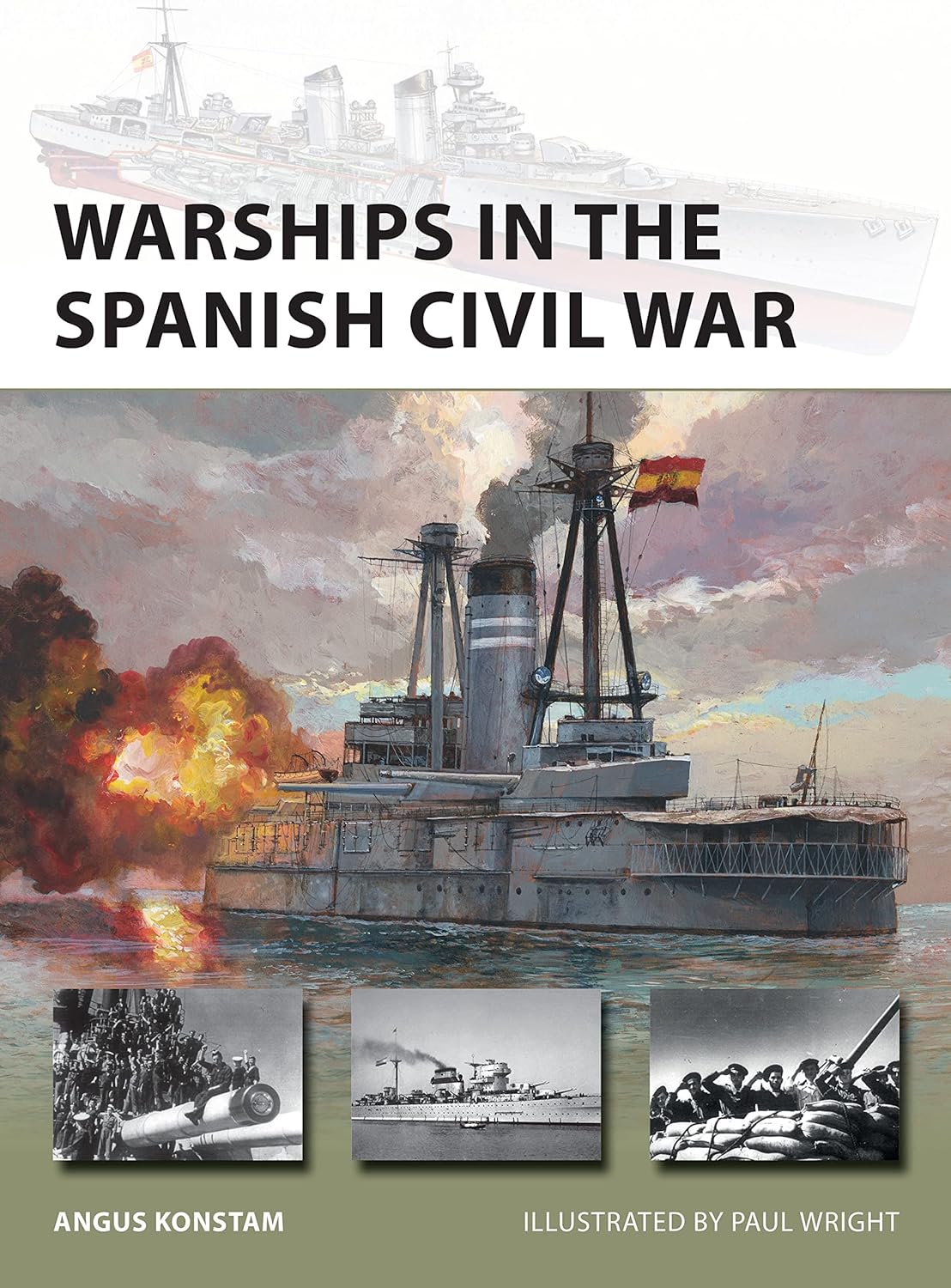Warships in the Spanish Civil War
By Angus Konstam

Angus Konstam sets out to cover 58 warships and their activities prior to and during the Spanish Civil War from April 1936 to July 1939. He condenses highly complex alliances and covers Spanish navies from centuries ago to their defeat in Cuba and Philippines in the 1898 Spanish-American War, from which the fleet never recovered.
The early civil war played out from North Africa to Iberia, the Balearic Islands, even involving the North Sea and Adriatic. The final year of Spain's naval war against itself was narrowed down to the Western Mediterranean, at which point Franco and his allies in Italy and Germany overwhelmed the Republicans, backed by the USSR and volunteers.
The strength of this book lies in being dispassionate, fully-illustrated and well-captioned. Konstam's conclusion informs his thesis: "The naval war ended with a whimper rather than a bang. It had always been…secondary to the land campaign, but…without it, and the supplies it helped escort into the country, the Republic would have been hard-pressed to resist the Nationalists for so long"
It is a great relief that Konstam immediately steers readers through the minefields of politics and jargon and designates communists, anarchists and trade unionists as Republicans. Although they won an election, the Republicans managed to alienate the Church, landowners, and monarchists, who along with the fascist-nationalist Falangists became Nationalists, firmly under General Franco. The Republicans started out with vastly more naval ships yet suffered from fewer officers, a diffuse command structure, and shipyard delays.
The timeline centers on Franco entering Peninsular Spain, breaking the coup's stalemate with the Nationalist Army of Africa. The Republican failure to stop him, despite their having capital ships and he merely a few gunboats, was probably the most critical error of the war, a war won by avoiding each other's fleets rather than provoking pitched battles. The fleets included battleships, heavy cruisers, dreadnoughts, destroyers, submarines, and torpedo, hydrographic, sail-training, patrol, river, fishery protection, patrol, river, custom boats, as well as tugs and seaplane tenders.
The ships were crewed from a pool of around 19,000 men, including 1,166 officers. Another 1,000 served in the Navy Air Arm, which was impressively modem and complex, even if they trained on biplanes. A cadre of Marines protected naval bases and ships and were self-administered.
Many of the pivotal moments for both sides were self-inflicted failures: on Day One, the overall naval chief was killed and his chief of staff arrested. In part due to the class nature of the conflict, Republicans suffered acute crewing difficulties. Sailors revolted against officers, and officers who remained loyal had to consult with and abide by a Comite de Buque, or Ship's Committee. They had insufficiently experienced officers, and many of those ships under construction; one reads often about ships obsolete when delivered.
The focus of the naval civil war often feels more about blockades and smuggling arms. The Balearic ships were critical to the Nationalists, who held them against attack and used them to convoy Italian supplies to various fronts. One ship began the war in Equatorial Guinea, another off Morocco, one was built in Mexico, but almost all were built to British designs in Spain. The Italians were proxy warriors for Franco, committing 58 submarines that sank and terrorized a number of Republicans ships. Mussolini also sold four destroyers to the Nationalists, who later intercepted and sank the Soviet Union ship Komsomol. This provoked an outrage, and hardened French and British patrols in the Straits of Gibraltar. Stalin sent at least four motor torpedo boats.
Seven of the fleet were coal-fired, two were hybrid, and the balance of 49 ships used fuel oil or diesel oil; one was capable of 36 knots. Several lacked turret guns, some of which swept their own decks. Indeed, a battleship stuck fake wooden barrels on deck, while another, the heavy cruiser Baleares, borrowed turrets. Coal was a logistical supply problem, particularly for the Republicans.
Republican destroyers sank Baleares, killing790 sailors;469 survivors were rescued by the British when Baleares accidently fired a star shell above themselves. The Nationalist battleship Espana sank in April 1937 by hitting its compadres' mine off Santander. The Republican battleship Jaime I ran aground, then blew up at anchor. When the battle turned against them on the Biscay coast, Republican ships sailed to England and France. When, in 1939, their Mediterranean ports also fell, they were interned at Tunisia and Algeria, which were then controlled by France. Franco effectively forced the Republican fleet to flee to French North Africa in April 1939. When the war ended that July, there was no Republican fleet to evacuate its loyalists, forcing them to remain and suffer.
Konstam's work is clear, well-researched, and easy to follow. Of his 17 primary resources, seven are Spanish and one focused on the Italian side. The reader is left curious about how the German U-34 sank the Republican submarine C-3, or which Republican vessels were sunk by Italians or Germans.
The most striking omission is the lack of a single map or chart, offset by Konstam 's description of cities. In the case of Bilbao the publishers erroneously place it in the northwest. Konstam delineates a fascinating and compelling battleground about which, due to the lack of a single, cataclysmic event, most readers may be completely unaware.
- Oxford: Osprey Publishing, 2021
- 7-1/4” x 9-3/4”, softcover, 48 pages and 96 pages
- Illustrations, maps, bibliography, index. $19.00
- ISBN: 9781472848666
Reviewed by: Jeremy Costlow, Little Rock, Arkansa
